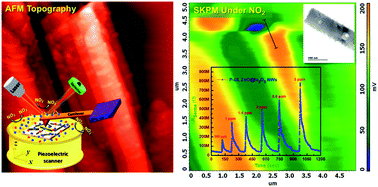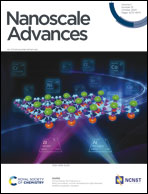Boosting the performance of NO2 gas sensors based on n–n type mesoporous ZnO@In2O3 heterojunction nanowires: in situ conducting probe atomic force microscopic elucidation of room temperature local electron transport†
Abstract
Herein, n–n type one dimensional ZnO@In2O3 heterojunction nanowires have been developed and their local electron transport properties during trace-level NO2 gas sensing process have been probed at room-temperature using conducting probe atomic microscopy. Solvothermally synthesized 1D ZnO@In2O3 heterojunction nanowires have been characterized by various spectroscopic and microscopic techniques, which revealed the mesoporous structure indicating their enhanced sensing properties. The dangling bonds and fraction of metal ions to oxygen ions existing on the exposed crystal facets of the heterojunction nanowires have been visualized by employing crystallographic simulations with TEM analysis, which aided in forecasting the nature of surface adsorption of NO2 gas species. In situ electrical characteristics and Scanning Spreading Resistance Microscopic (SSRM) imaging of single ZnO@In2O3 heterojunction nanowires revealed the local charge transport properties in n–n type ZnO@In2O3 heterojunction nanowires. Moreover, the ZnO@In2O3 heterojunction nanowires based sensor exhibited excellent sensitivity (S = 274%), a fast response (4–6 s) and high selectivity towards trace-level concentration (500 ppb) of NO2 gas under ambient conditions with low power consumption. Spatially resolved surface potential (SP) variations in ZnO@In2O3 heterojunction nanowires have been visualized using in situ Scanning Kelvin Probe Force Microscopy (SKPM) under NO2 gas environment at room temperature, which was further correlated with its energy band structure. The work functions of the material evaluated by SKPM reveal considerable changes in the energy band structure owing to the local electron transport between ZnO and In2O3 at the heterojunctions upon exposure to NO2 gas indicating the charge carrier recombination. A plausible mechanism has been proposed based on the experimental evidences. The results suggest that new insights into complex sensing mechanisms deduced from the present investigation on n–n type MOS based heterojunction nanowires under ambient conditions can pave the way for the novel design and development of affordable and superior real-time gas sensors.

- This article is part of the themed collection: Gas sensing


 Please wait while we load your content...
Please wait while we load your content...